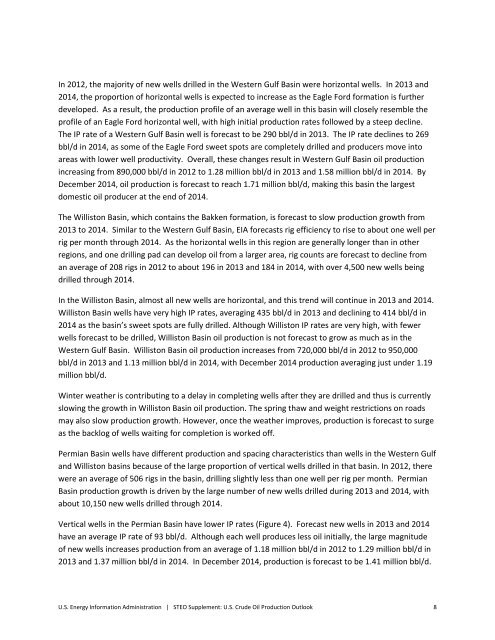Key drivers for EIA's short‐term US crude oil production outlook
Key drivers for EIA's short‐term US crude oil production outlook
Key drivers for EIA's short‐term US crude oil production outlook
Create successful ePaper yourself
Turn your PDF publications into a flip-book with our unique Google optimized e-Paper software.
In 2012, the majority of new wells drilled in the Western Gulf Basin were horizontal wells. In 2013 and<br />
2014, the proportion of horizontal wells is expected to increase as the Eagle Ford <strong>for</strong>mation is further<br />
developed. As a result, the <strong>production</strong> profile of an average well in this basin will closely resemble the<br />
profile of an Eagle Ford horizontal well, with high initial <strong>production</strong> rates followed by a steep decline.<br />
The IP rate of a Western Gulf Basin well is <strong>for</strong>ecast to be 290 bbl/d in 2013. The IP rate declines to 269<br />
bbl/d in 2014, as some of the Eagle Ford sweet spots are completely drilled and producers move into<br />
areas with lower well productivity. Overall, these changes result in Western Gulf Basin <strong>oil</strong> <strong>production</strong><br />
increasing from 890,000 bbl/d in 2012 to 1.28 million bbl/d in 2013 and 1.58 million bbl/d in 2014. By<br />
December 2014, <strong>oil</strong> <strong>production</strong> is <strong>for</strong>ecast to reach 1.71 million bbl/d, making this basin the largest<br />
domestic <strong>oil</strong> producer at the end of 2014.<br />
The Williston Basin, which contains the Bakken <strong>for</strong>mation, is <strong>for</strong>ecast to slow <strong>production</strong> growth from<br />
2013 to 2014. Similar to the Western Gulf Basin, EIA <strong>for</strong>ecasts rig efficiency to rise to about one well per<br />
rig per month through 2014. As the horizontal wells in this region are generally longer than in other<br />
regions, and one drilling pad can develop <strong>oil</strong> from a larger area, rig counts are <strong>for</strong>ecast to decline from<br />
an average of 208 rigs in 2012 to about 196 in 2013 and 184 in 2014, with over 4,500 new wells being<br />
drilled through 2014.<br />
In the Williston Basin, almost all new wells are horizontal, and this trend will continue in 2013 and 2014.<br />
Williston Basin wells have very high IP rates, averaging 435 bbl/d in 2013 and declining to 414 bbl/d in<br />
2014 as the basin’s sweet spots are fully drilled. Although Williston IP rates are very high, with fewer<br />
wells <strong>for</strong>ecast to be drilled, Williston Basin <strong>oil</strong> <strong>production</strong> is not <strong>for</strong>ecast to grow as much as in the<br />
Western Gulf Basin. Williston Basin <strong>oil</strong> <strong>production</strong> increases from 720,000 bbl/d in 2012 to 950,000<br />
bbl/d in 2013 and 1.13 million bbl/d in 2014, with December 2014 <strong>production</strong> averaging just under 1.19<br />
million bbl/d.<br />
Winter weather is contributing to a delay in completing wells after they are drilled and thus is currently<br />
slowing the growth in Williston Basin <strong>oil</strong> <strong>production</strong>. The spring thaw and weight restrictions on roads<br />
may also slow <strong>production</strong> growth. However, once the weather improves, <strong>production</strong> is <strong>for</strong>ecast to surge<br />
as the backlog of wells waiting <strong>for</strong> completion is worked off.<br />
Permian Basin wells have different <strong>production</strong> and spacing characteristics than wells in the Western Gulf<br />
and Williston basins because of the large proportion of vertical wells drilled in that basin. In 2012, there<br />
were an average of 506 rigs in the basin, drilling slightly less than one well per rig per month. Permian<br />
Basin <strong>production</strong> growth is driven by the large number of new wells drilled during 2013 and 2014, with<br />
about 10,150 new wells drilled through 2014.<br />
Vertical wells in the Permian Basin have lower IP rates (Figure 4). Forecast new wells in 2013 and 2014<br />
have an average IP rate of 93 bbl/d. Although each well produces less <strong>oil</strong> initially, the large magnitude<br />
of new wells increases <strong>production</strong> from an average of 1.18 million bbl/d in 2012 to 1.29 million bbl/d in<br />
2013 and 1.37 million bbl/d in 2014. In December 2014, <strong>production</strong> is <strong>for</strong>ecast to be 1.41 million bbl/d.<br />
U.S. Energy In<strong>for</strong>mation Administration | STEO Supplement: U.S. Crude Oil Production Outlook 8
















